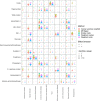This is a preprint.
Associations of Circulating Biomarkers with Disease Risks: a Two-Sample Mendelian Randomization Study
- PMID: 39006413
- PMCID: PMC11245069
- DOI: 10.1101/2024.06.30.24309729
Associations of Circulating Biomarkers with Disease Risks: a Two-Sample Mendelian Randomization Study
Update in
-
Associations of Circulating Biomarkers with Disease Risks: A Two-Sample Mendelian Randomization Study.Int J Mol Sci. 2024 Jul 5;25(13):7376. doi: 10.3390/ijms25137376. Int J Mol Sci. 2024. PMID: 39000484 Free PMC article.
Abstract
Background: Circulating biomarkers play a pivotal role in personalized medicine, offering potential for disease screening, prevention, and treatment. Despite established associations between numerous biomarkers and diseases, elucidating their causal relationships is challenging. Mendelian Randomization (MR) can address this issue by employing genetic instruments to discern causal links. Additionally, using multiple MR methods with overlapping results enhances the reliability of discovered relationships.
Methods: Here we report an MR study using multiple methods, including inverse variance weighted, simple mode, weighted mode, weighted median, and MR Egger. We use the MR-base resource (v0.5.6)1 to evaluate causal relationships between 212 circulating biomarkers (curated from UK Biobank analyses by Neale lab and from Shin et al. 2014, Roederer et al. 2015, and Kettunen et al. 2016)2-4 and 99 complex diseases (curated from several consortia by MRC IEU and Biobank Japan).
Results: We report novel causal relationships found by 4 or more MR methods between glucose and bipolar disorder (Mean Effect Size estimate across methods: 0.39) and between cystatin C and bipolar disorder (Mean Effect Size: -0.31). Based on agreement in 4 or more methods, we also identify previously known links between urate with gout and creatine with chronic kidney disease, as well as biomarkers that may be causal of cardiovascular conditions: apolipoprotein B, cholesterol, LDL, lipoprotein A, and triglycerides in coronary heart disease, as well as lipoprotein A, LDL, cholesterol, and apolipoprotein B in myocardial infarction.
Conclusions: This Mendelian Randomization study not only corroborates known causal relationships between circulating biomarkers and diseases but also uncovers two novel biomarkers associated with bipolar disorder that warrant further investigation. Our findings provide insight into understanding how biological processes reflecting circulating biomarkers and their associated effects may contribute to disease etiology, which can eventually help improve precision diagnostics and intervention.
Keywords: Biomarkers; Human Disease; Mendelian Randomization; Metabolome; Proteome.
Conflict of interest statement
Conflicts of Interest: The authors declare no conflict of interest.
Figures


Similar articles
-
Associations of Circulating Biomarkers with Disease Risks: A Two-Sample Mendelian Randomization Study.Int J Mol Sci. 2024 Jul 5;25(13):7376. doi: 10.3390/ijms25137376. Int J Mol Sci. 2024. PMID: 39000484 Free PMC article.
-
Causal effects of circulating lipids and lipid-lowering drugs on the risk of urinary stones: a Mendelian randomization study.Front Endocrinol (Lausanne). 2023 Dec 1;14:1301163. doi: 10.3389/fendo.2023.1301163. eCollection 2023. Front Endocrinol (Lausanne). 2023. PMID: 38107516 Free PMC article.
-
Causal effects of circulating lipids and lipid-lowering drugs on the risk of epilepsy: a two-sample Mendelian randomization study.QJM. 2023 Jun 8;116(6):421-428. doi: 10.1093/qjmed/hcad048. QJM. 2023. PMID: 36964718
-
Exploring the causal effect between lipid-modifying drugs and idiopathic pulmonary fibrosis: a drug-target Mendelian randomization study.Lipids Health Dis. 2024 Aug 1;23(1):237. doi: 10.1186/s12944-024-02218-6. Lipids Health Dis. 2024. PMID: 39090671 Free PMC article.
-
Estimating causal effects of atherogenic lipid-related traits on COVID-19 susceptibility and severity using a two-sample Mendelian randomization approach.BMC Med Genomics. 2021 Nov 13;14(1):269. doi: 10.1186/s12920-021-01127-2. BMC Med Genomics. 2021. PMID: 34774031 Free PMC article.
References
-
- Ruzickova MS, C. Garnham J., Alda M. Clinical Features of Bipolar Disorder With and WithoutComorbid Diabetes Mellitus. The Canadian Journal of Psychiatry 2003;48(7):431–502. - PubMed
Publication types
Grants and funding
LinkOut - more resources
Full Text Sources
Miscellaneous
